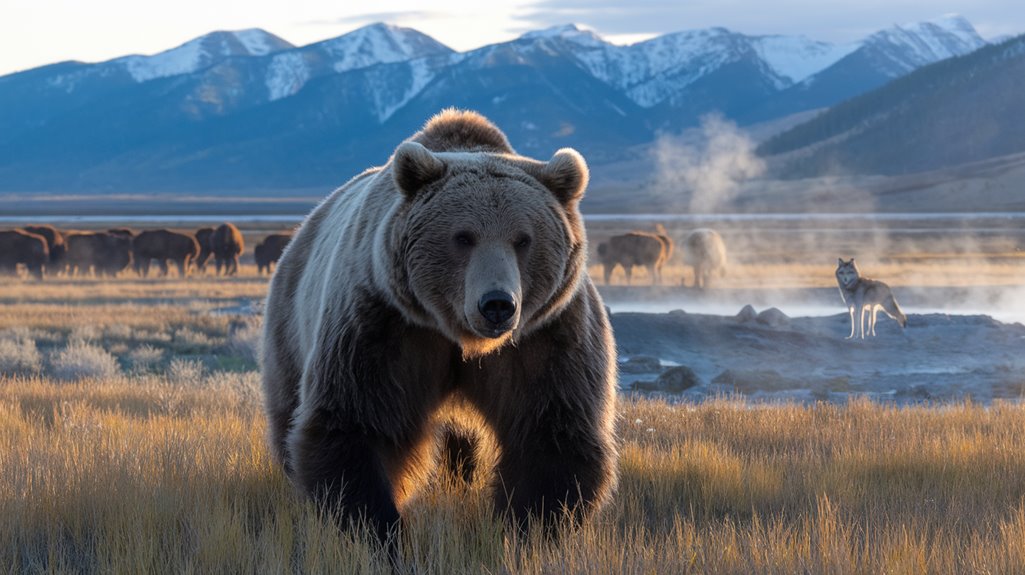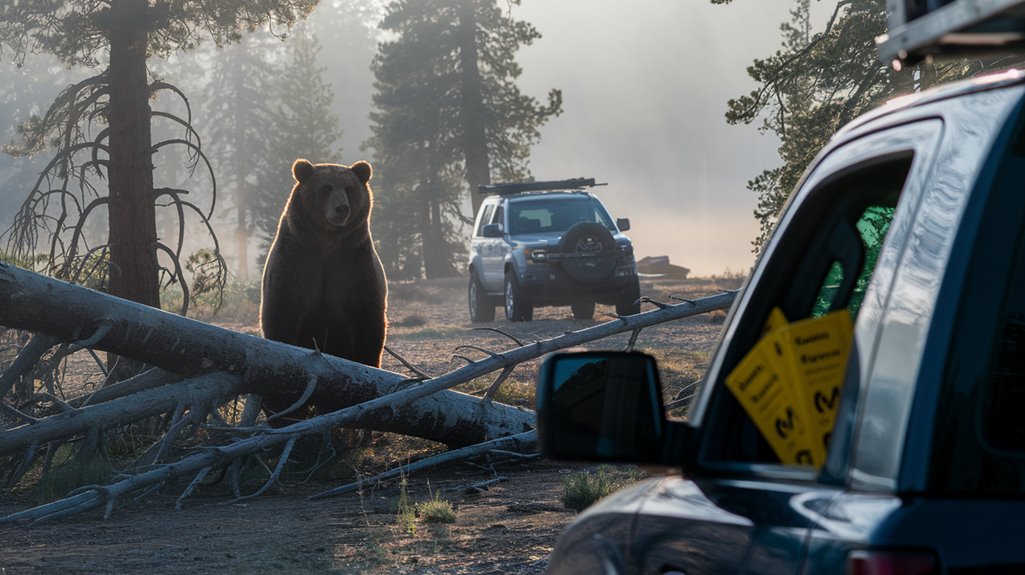While millions flock to Yellowstone's geothermal wonders, you'll find the park's true magic in its diverse wildlife. As North America's premier wildlife sanctuary, Yellowstone provides unparalleled opportunities to witness iconic species in their natural habitat. You can observe grizzlies foraging in meadows, watch wolf packs coordinate their hunts, or stand in awe as massive bison herds thunder across the plains. Whether you're an experienced naturalist or a casual observer, these ten remarkable creatures will transform your understanding of wilderness and what it means to truly coexist with nature.
Key Takeaways
- Grizzly bears are best spotted in meadows during dawn and dusk, identifiable by their distinctive shoulder hump and concave face.
- Gray wolves hunt in packs throughout the northern range, offering spectacular viewing opportunities of pack dynamics and hunting behavior.
- Massive bison herds provide year-round viewing, with peak activity during summer breeding season in Hayden and Lamar Valleys.
- Bull elk showcase dramatic rutting behavior from September to mid-October, particularly visible around Mammoth Hot Springs.
- Pronghorns, bighorn sheep, river otters, bald eagles, and coyotes offer diverse wildlife viewing experiences throughout the park.
Grizzly Bears in Action
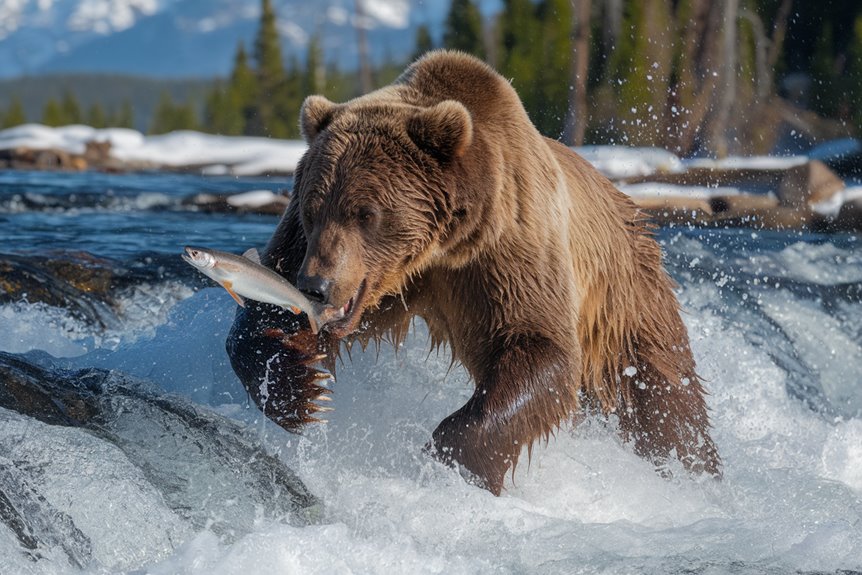
The majesty of Yellowstone's grizzly bears comes to life in the park's sprawling meadows and valleys.
You'll find these powerful omnivores most active at dawn and dusk, especially in prime viewing locations like Lamar Valley, Hayden Valley, and Swan Lake Flats. With over 1,000 grizzlies now thriving in the Greater Yellowstone Ecosystem, your chances of spotting one have never been better.
You can identify a grizzly by its distinctive shoulder hump, concave face, and smaller ears compared to black bears.
Watch them dig for roots and rodents in open meadows, hunt elk calves in spring, or feast on winter-killed carcasses. During fall's hyperphagia, you'll see them intensify their foraging as they prepare for hibernation.
Remember to maintain a safe 100-yard distance and use binoculars for the best viewing encounter.
Wild Wolf Packs
Throughout Yellowstone's vast wilderness, gray wolves have made a remarkable comeback since their 1995 reintroduction, with 124 wolves now living in 11 packs across the park.
You'll find these intelligent predators primarily hunting elk, with pack sizes ranging from 2 to 25 members, averaging about 12 wolves per pack.
If you're hoping to spot wolves, you'll need to understand that they're most active in the park's northern range, where prey is abundant.
While they're naturally wary of humans, some packs have become more visible in high-tourist areas.
Keep in mind that wolves don't stay within park boundaries – they often venture into Montana and Wyoming.
The best viewing opportunities come at dawn and dusk, when packs are most active in their territories.
Majestic Bison Herds
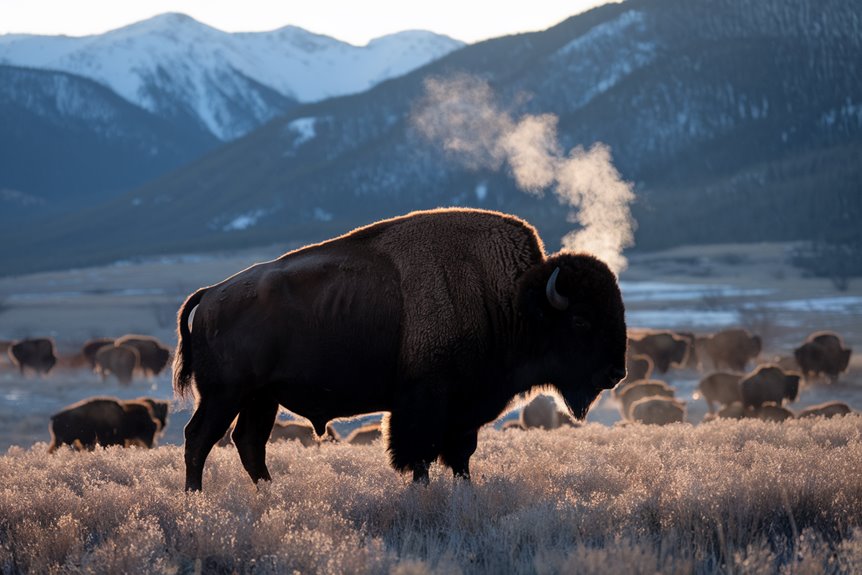
Massive herds of bison roam freely across Yellowstone's iconic valleys, representing North America's largest remaining wild population of these magnificent creatures.
You'll find these 2,000-pound giants grazing in the Hayden and Lamar Valleys, where they spend 9-11 hours daily foraging on grasses and sedges.
During summer breeding season, you can witness impressive displays as bulls compete for mating rights through bellowing and fighting.
To best appreciate Yellowstone's bison:
- Visit during July-August to observe dramatic rutting behavior when herds gather in groups up to 1,000 strong
- Look for newborn calves in April-May, especially in lower elevation valleys
- Keep a safe distance – despite their size, these powerful animals can sprint three times faster than humans and are unpredictable
Elk During the Rut
During fall's crisp mornings and cool evenings, you'll witness one of Yellowstone's most dramatic natural displays – the elk rut. From September through mid-October, bull elk gather harems of females and defend them fiercely against rivals, filling the air with their distinctive bugling calls.
You can safely observe this spectacular mating ritual at several prime locations, including Mammoth Hot Springs, Lamar Valley, and along the Madison River. Remember to maintain at least 25 yards distance, as bulls become extremely aggressive during this time.
Use a long lens for photography, and always follow ranger instructions. For the best viewing encounter, watch from your vehicle or designated viewing areas.
The Elk Rut Corps Volunteers and park rangers are on hand to guarantee your safety while you enjoy this remarkable wildlife spectacle.
Playful River Otters
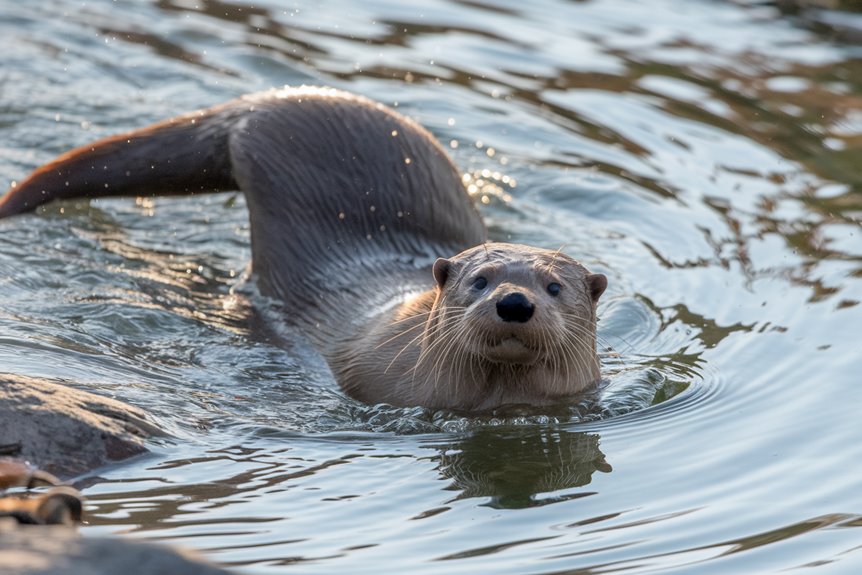
Yellowstone's river otters captivate visitors with their playful antics and remarkable swimming abilities.
These sleek, cylindrical members of the weasel family can swim up to 6 miles per hour and hold their breath for up to 3 minutes. You'll find them most active during early morning and evening hours, especially around Trout Lake, Lamar River, and Soda Butte Creek.
To maximize your chances of spotting these charismatic creatures:
- Visit during late spring when they concentrate around spawning areas for cutthroat trout
- Look for them along riverbanks where they're known to frolic and play
- Watch for their distinctive tapered tails breaking the water's surface as they hunt for fish
Mother otters raise 2-4 pups annually, teaching them essential swimming and hunting skills until they're ready for independence.
Bighorn Sheep on Cliffs
Countless visitors stand in awe as they watch bighorn sheep navigate Yellowstone's steep cliffs with remarkable agility.
You'll find these expert climbers in fragmented populations across the park's mountainous terrain, particularly in Lamar Valley. The males, known for their massive curved horns weighing up to 30 pounds, put on an impressive show during fall mating season when they compete for females through dramatic head-butting contests.
If you're hoping to photograph these magnificent creatures, head out during early morning or late evening.
You'll want to focus your attention on rocky areas and cliffs where they're most active. Remember to maintain a respectful distance and let them move freely in their natural habitat.
The park's protection efforts help guarantee these incredible animals continue to thrive in Yellowstone's rugged landscape.
Bald Eagles Soaring Above
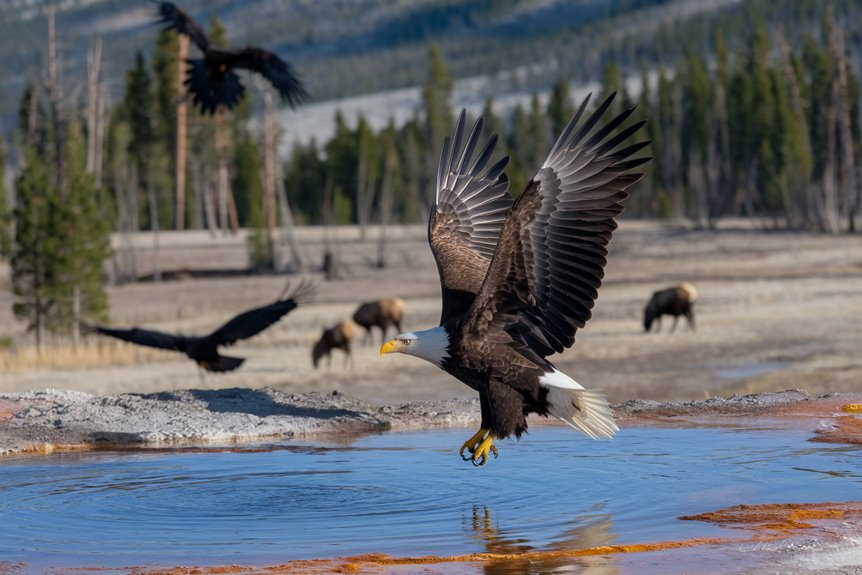
Anyone lucky enough to visit Yellowstone can witness America's national bird soaring majestically above the park's expansive waterways.
You'll spot these massive raptors near Hayden Valley and Yellowstone Lake, where they build enormous nests up to 12 feet high in tall trees. With wingspans reaching 8 feet, these year-round residents cruise at speeds of 35-44 MPH while hunting for fish and small mammals.
To maximize your chances of seeing bald eagles in Yellowstone:
- Scan the skies above major rivers and lakes, especially during morning hours
- Look for their distinctive white heads and massive nests in trees near water
- Visit Hayden Valley, where eagles often gather to fish and scavenge
Black Bears Foraging
To observe these bears safely, focus your attention on forested areas during cooler hours.
But remember they're wild animals that require distance and respect.
Pronghorn at Full Speed
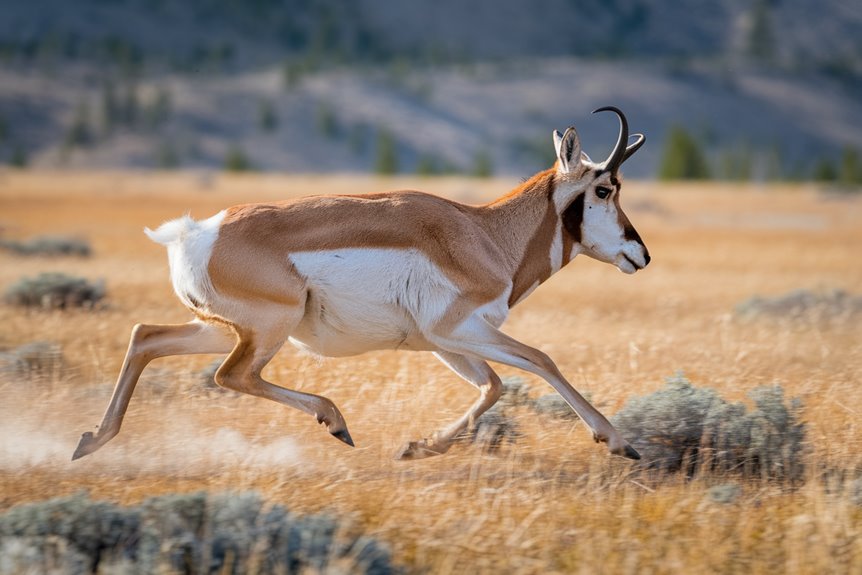
While black bears move quietly through Yellowstone's forests, another remarkable creature races across its open plains at breathtaking speeds.
You'll spot pronghorns by their distinctive reddish-tan coat, white rump patch, and black cheek markings on males. These incredible athletes can sprint at sustained speeds of 45-50 mph, with bursts up to 60 mph, making them North America's fastest land mammal.
To maximize your chances of witnessing these swift creatures:
- Look for mixed-sex herds in winter months when they gather in larger groups
- Scan open terrain during dawn and dusk when they're most active
- Watch for their characteristic bounding gait as they navigate between summer and winter ranges
Their fawns are especially remarkable, able to outrun humans within days of birth.
Coyotes on the Hunt
Prowling through Yellowstone's diverse terrain, coyotes demonstrate remarkable hunting abilities that make them one of the park's most successful predators.
You'll find these adaptable canines hunting alone or in packs, using their acute hearing and smell to locate prey buried in snow. They're incredibly agile, reaching speeds up to 40 mph and leaping 13 feet.
You'll spot these 25-35 pound hunters in various habitats throughout the park, from forests to grasslands.
They're most successful when hunting small mammals, but they'll also take down larger prey like elk calves when hunting in groups.
While wolves have impacted their behavior since reintroduction in 1995, coyotes have proven resilient, maintaining their essential role in Yellowstone's ecosystem with a 35% hunting success rate.
Frequently Asked Questions
What Time of Year Are Most Baby Animals Born in Yellowstone?
You'll find most baby animals being born in Yellowstone during spring, particularly from late April through early June, when elk, bison, bighorn sheep, moose, and pronghorn welcome their newborns.
How Close Can Visitors Safely Get to Photograph Different Wildlife Species?
Think you're the next wildlife paparazzi? Keep 100 yards from predators like bears and wolves, and 25 yards from ungulates like bison and elk. Use those telephoto lenses instead!
Which Wildlife Viewing Locations Are Accessible for Visitors With Mobility Limitations?
You'll find accessible wildlife viewing at Hayden Valley, Lamar Valley, Madison River area, and Grand Loop Road pullouts. The Lake Hotel area provides paved pathways for viewing wildlife near Yellowstone Lake.
Do Any Yellowstone Animals Remain Active and Visible During Winter Months?
You'll find many active winter animals, including wolves in Lamar Valley, bison near geothermal areas, coyotes hunting in northern regions, and eagles fishing along open rivers.
What Special Permits or Passes Are Needed for Wildlife Photography?
Like a worry-free path through the park, you won't need special permits for personal wildlife photography. You'll only need a permit if you're doing commercial work for profit.
